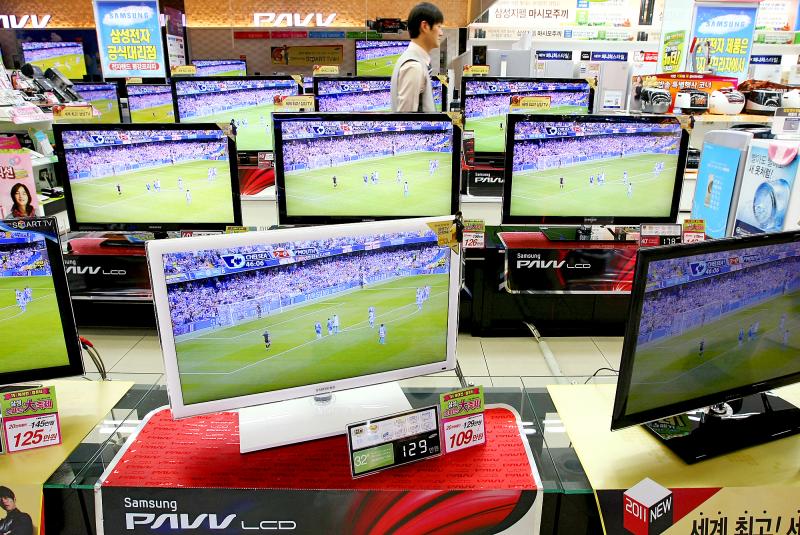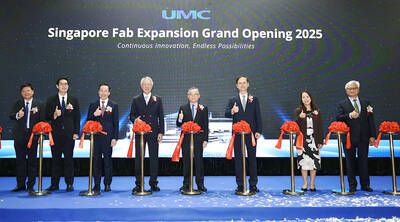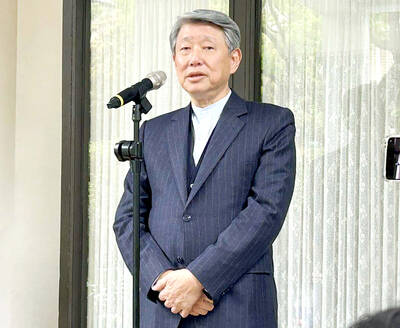Samsung Display Co’s plans to continue manufacturing LCD panels in South Korea are not expected to affect market dynamics in the first half of this year, but might exacerbate a supply glut during the second half, market researcher TrendForce Corp (集邦科技) said in a note on Thursday.
The display unit of Samsung Electronics Co last week said that it would extend its production of panels for TVs and monitors due to COVID-19-driven demand, reversing its announcement in March last year that it would end all production by the end of the year to pursue a technology upgrade.
“Despite previous expectations [that it would] shutter its LCD panel manufacturing operations, Samsung Display will continue manufacturing panels in South Korea, with one 7-generation and two 8.5-generation production lines operating throughout the first quarter of 2021,” TrendForce said.

Photo: Bloomberg
“However, in consideration of costs, technological transition schedules and client demand for specific panel sizes, Samsung Display is expected to retain manufacturing operations at only one 8.5-generation production line in the fourth quarter of 2021,” the Taipei-based research firm said, adding that Samsung Display’s continued panel manufacturing is expected to conclude by the end of this year.
Given persisting component shortages, coupled with steady demand for display panels used in TVs, monitors and laptops, overall LCD panel supply and demand is predicted to mostly remain balanced until the end of the first half, despite Samsung Display’s plan to extend LCD manufacturing, TrendForce said.
However, the research firm did not rule out the possibility of a supply glut in the second half, even though Samsung Display has pledged to sell all of its panels to Samsung Electronics, which has historically been the largest purchaser of display panels, it said.
“The increased panel supply from Samsung Display certainly represents a potential risk that may disrupt the panel industry’s supply and demand equilibrium,” TrendForce said. “Whether Samsung Electronics will shift its panel purchasing strategies in response [to the supply of panels from Samsung Display] will remain an important point of observation for the panel market in 2021.”
In related news, NH Investment & Securities Co expects LCD panel prices, which were high at the end of last year, to continue rising in the first quarter due to an anticipated decrease in glass substrate supply.
That is because Japan-based glass substrate maker Nippon Electric Glass Co (NEG) had a power outage for five hours in its Takatsuki plant in Japan on Dec. 10, the Seoul-based securities firm said in a note on Wednesday.
As the incident damaged five glass furnaces at the Takatsuki plant and might affect NEG’s shipments for about a quarter, NH Investment said that South Korean panel makers and their Taiwanese peers could find it hard to source glass substrate in the short term, which would maintain panel prices into the first quarter.
LCD panel prices would likely remain flat in the second quarter compared with the first quarter due to an acceleration in panel production alongside normalized supply of glass substrates, the securities firm said.
However, panel prices are forecast to decline from the third quarter, as supply should exceed demand due to ongoing production expansion by Chinese manufacturers, centering on facilities that are eighth generation and above, NH Investment said.

‘SWASTICAR’: Tesla CEO Elon Musk’s close association with Donald Trump has prompted opponents to brand him a ‘Nazi’ and resulted in a dramatic drop in sales Demonstrators descended on Tesla Inc dealerships across the US, and in Europe and Canada on Saturday to protest company chief Elon Musk, who has amassed extraordinary power as a top adviser to US President Donald Trump. Waving signs with messages such as “Musk is stealing our money” and “Reclaim our country,” the protests largely took place peacefully following fiery episodes of vandalism on Tesla vehicles, dealerships and other facilities in recent weeks that US officials have denounced as terrorism. Hundreds rallied on Saturday outside the Tesla dealership in Manhattan. Some blasted Musk, the world’s richest man, while others demanded the shuttering of his

TIGHT-LIPPED: UMC said it had no merger plans at the moment, after Nikkei Asia reported that the firm and GlobalFoundries were considering restarting merger talks United Microelectronics Corp (UMC, 聯電), the world’s No. 4 contract chipmaker, yesterday launched a new US$5 billion 12-inch chip factory in Singapore as part of its latest effort to diversify its manufacturing footprint amid growing geopolitical risks. The new factory, adjacent to UMC’s existing Singapore fab in the Pasir Res Wafer Fab Park, is scheduled to enter volume production next year, utilizing mature 22-nanometer and 28-nanometer process technologies, UMC said in a statement. The company plans to invest US$5 billion during the first phase of the new fab, which would have an installed capacity of 30,000 12-inch wafers per month, it said. The

MULTIFACETED: A task force has analyzed possible scenarios and created responses to assist domestic industries in dealing with US tariffs, the economics minister said The Executive Yuan is tomorrow to announce countermeasures to US President Donald Trump’s planned reciprocal tariffs, although the details of the plan would not be made public until Monday next week, Minister of Economic Affairs J.W. Kuo (郭智輝) said yesterday. The Cabinet established an economic and trade task force in November last year to deal with US trade and tariff related issues, Kuo told reporters outside the legislature in Taipei. The task force has been analyzing and evaluating all kinds of scenarios to identify suitable responses and determine how best to assist domestic industries in managing the effects of Trump’s tariffs, he

Taiwan’s official purchasing managers’ index (PMI) last month rose 0.2 percentage points to 54.2, in a second consecutive month of expansion, thanks to front-loading demand intended to avoid potential US tariff hikes, the Chung-Hua Institution for Economic Research (CIER, 中華經濟研究院) said yesterday. While short-term demand appeared robust, uncertainties rose due to US President Donald Trump’s unpredictable trade policy, CIER president Lien Hsien-ming (連賢明) told a news conference in Taipei. Taiwan’s economy this year would be characterized by high-level fluctuations and the volatility would be wilder than most expect, Lien said Demand for electronics, particularly semiconductors, continues to benefit from US technology giants’ effort